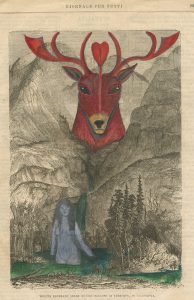La scena dell’arte (The Art Scene) is the first widespread contemporary art project realized around the Lake Como, connecting the two historically different shores: one is that of international tourism and the other is the manufacturing heart. The project, conceived and produced by the cultural association ArchiViVitali, inaugurates the collaboration with Villa Carlotta, a prologue for future and interesting developments.
The project La scena dell’arte has been structured according two different but complementary modes, for which in one of the two shores, in Bellano, at the Spazio Circolo, we can find the collective show Straniamenti, with twenty-five artists, and in the other part, at Villa Carlotta, there is Il teatro segreto with only two artists: Antonio Marras and Ferdinando Bruni, who reinterpret the spaces of the villa where there can be found some wonderful artworks by Canova, Thorvaldsen, Appiani, Hayez, Perugino and so on.
In Bellano, at Spazio Circolo, we are greeted by a series of curtains, scenic elements that lead to the “maschera di sala” by Paolo Ventura ready to welcome us and then to close in his suitcase, up to enter the room where the first thing that catches the eye is a large suspended red silhouette designed by Emilio Tadini in 2000.
In this particular situation stage fiction and theatrical narration is, from a chair-window, looking at a Stella (Star), 2021, or at a very bright Luna (Moon), 2022, that fell on the ground or at Pesca di stelle (Starfishing), 2018, by Marcello Chiarenza; it is a Bustino di gabbia (Cage bustier) made for L’Ambleto di Giovanni Testori in 1973, or the structure of Cavallo (Horse) to wear from 1990 by Gian Maurizio Fercioni. It is also the mask of Tiresias for Oedipus the Tyrant of Sophocles of 1993 by Matteo Solo, or the very African Maschera di Minotauro (Minotaur Mask) by Mimmo Paladino from 2019 or, again, by Matteo Soltanto, the sketch Prigione (Cage), 1990, for High Surveillance by Jean Jenet, so such as the Cuore del teatro (Heart of the theater) sketch from 2018 by Giosetta Fioroni, or the watercolor and pencil on paper by Nicola Benois, Costume studies for Stravinsky’s “Perséphone” from 1965, The hours of day and night, 1955. And, finally, the works by Armin Linke, Pier Luigi Pizzi, Maria Spazzi, Claudia Losi, Francesca Montinaro, Luigi Mainolfi, Fabrizio Plessi, Sottsass…
Villa Carlotta is in itself all a reference to the theater as the Duke George II of Saxony-Meiningen was a lover of the performing arts dedicating himself to the theater for his entire life, both in the rooms on the second floor, in the furnishings of the studio, in the splendid Hall delle Vedute, and in the garden, with its views and the rare botanical species. Here Ferdinando Bruni and Antonio Marras interact with each other with paintings on the walls and the other in the center of the room on tables with a series of objects and mannequins on one side, and on the other, screens showing scraps of ironed fabrics. Ferdinando Bruni offers ten large unpublished paintings from The sweet derision of the crow cycle with various quotes including a Spanish proverb “Raise crows and they will peck your eyes”, as in Saura’s 1976 film Cría Cuervos.
Bruni’s disturbing red canvases show situations and monstrous figures looking at Antonio Marras’ tables, which are full of objects and are part of his memory and of mannequins that refer to the bodies of the queens and the princesses who frequented these spaces. All according to his style that we have already had the opportunity to appreciate in the very rich exhibition at the Triennale, in Milan, a few years ago.
Emanuele Magri
Info:
AA.VV., La scena dell’arte
a cura di Velasco Vitali
02/07/2022 – 06/11/2022
In collaborazione con ArchiViVitali e Villa Carlotta
Villa Carlotta, via Regina 2, 22016 Tramezzina, Tramezzo, Como
Spazio Circolo, via Alessandro Manzoni 50, 23822 Bellano, Lecco
https://www.villacarlotta.it
https://archivivitali.org/
 Nicola Benois, costume studies for Stravinsky’s “Perséphone” from 1965, The Hours of Day and Night, 1955, watercolor and pencil on paper, 29,7 x 42 cm, courtesy ArchiViVitali
Nicola Benois, costume studies for Stravinsky’s “Perséphone” from 1965, The Hours of Day and Night, 1955, watercolor and pencil on paper, 29,7 x 42 cm, courtesy ArchiViVitali
 Ferdinando Bruni, watercolor on paper, 21 x 29,7 cm, courtesy ArchiViVitali
Ferdinando Bruni, watercolor on paper, 21 x 29,7 cm, courtesy ArchiViVitali

Emanuele Magri teaches History of Art in Milan. Since 2007 he has been writing abroad for Juliet art Magazine. Since the 1970s he has dealt with writing and visual arts. He created taxonomically defined worlds, in which he experimented with the self-referentiality of language, such as “La Setta delle S’arte” in which ritual clothes are made starting from words with multiple meanings, the “Treaty of genetic art” in which a series of plants is obtained from grafts of human organs, eyes, hands, mouths, etc., and the project “Fandonia”, a city where everything is double and hybrid.






NO COMMENT